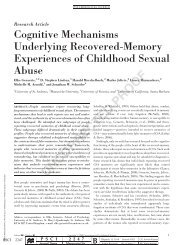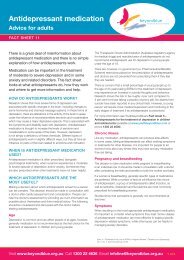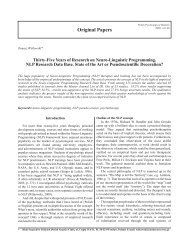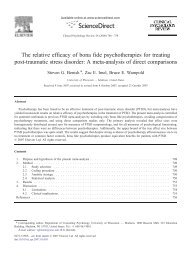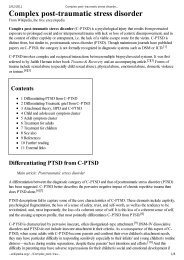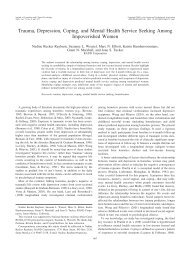The Sociocognitive Model of Dissociative Identity Disorder: A ...
The Sociocognitive Model of Dissociative Identity Disorder: A ...
The Sociocognitive Model of Dissociative Identity Disorder: A ...
You also want an ePaper? Increase the reach of your titles
YUMPU automatically turns print PDFs into web optimized ePapers that Google loves.
48 GLEAVES<br />
tual error (Ross, 1988), and a stated goal <strong>of</strong> treatment is to<br />
communicate this to the patient (Putnam, 1989; Ross, 1989).<br />
Conceptualizations <strong>of</strong> alters. Proponents <strong>of</strong> the sociocognitive<br />
model suggest that the issue <strong>of</strong> alters should not be legitimized<br />
by making a diagnosis <strong>of</strong> DID, speaking about alters as if<br />
they are real or genuine, or both. Rather, proponents recommend<br />
that alters should be ignored (e.g., McHugh, 1993). <strong>The</strong><br />
argument is based on the logic that to speak <strong>of</strong> alters as real<br />
would reify them in the minds <strong>of</strong> a confused and suggestible<br />
patient, thus worsening his or her condition.<br />
This common argument appears to be based on misunderstandings<br />
over the phenomenology <strong>of</strong> DID, the use and<br />
meaning <strong>of</strong> the terms real or genuine, and the recommended<br />
therapy <strong>of</strong> DID. Skeptics <strong>of</strong> the reality <strong>of</strong> DID seem to assume<br />
that therapists who treat patients with DID conceptualize alters<br />
as different people or entities or conceptualize patients with<br />
DID as having more than one personality. Skeptics then use<br />
such a conceptualization to express doubt about the reality <strong>of</strong><br />
the condition. For example, in their review, North et al. (1993,<br />
p. 31) cited Prasad's statement that "the concept that more than<br />
one person may exist within one body is so alien to common<br />
sense that it borders on the supernatural." Although this perception<br />
may be quite common, it is in fact a misconception.<br />
This common confusion over the phenomenology <strong>of</strong> DID<br />
may have been caused by the media's descriptions <strong>of</strong> the disorder<br />
or by the previous diagnostic label (multiple personality<br />
disorder), which seemed to imply the presence <strong>of</strong> more than<br />
one personality. However, several researchers (e.g., Kluft, 1988;<br />
Ross, 1990) have noted that the label was a misnomer, and the<br />
confusion <strong>of</strong> terms is what led to the recent name change in the<br />
DSM-1V. David Spiegel, who was chair <strong>of</strong> the Z>5jV/-/Kwork<br />
group on dissociative disorders, described that the reason for<br />
the change was to emphasize the fundamental problem <strong>of</strong> the<br />
disorder, that <strong>of</strong> "a difficulty in integrating various aspects <strong>of</strong><br />
personality rather than a pr<strong>of</strong>usion <strong>of</strong> personalities" (Fraser,<br />
1994, p. II).<br />
However, research does demonstrate that patients with DID<br />
report experiencing dissociated parts <strong>of</strong> themselves as separate<br />
people or entities (Ross et al., 1990). In many cases, such a<br />
quasi-delusional perception may lead to severe acts <strong>of</strong> selfinjury<br />
(e.g., "It's not my body, it's hers"). What is critical to<br />
understand is that acknowledging a patient with DID to have<br />
genuine experience <strong>of</strong> alters as real people or entities is not the<br />
same as stating that alters are actually real people or entities.<br />
An analogy with another mental disorder may help clarify the<br />
distinction. Many individuals with anorexia nervosa state that<br />
they experience themselves as obese, even though they are emaciated.<br />
To tell such a patient that one understands and believes<br />
that he or she experiences the self in that fashion is not the same<br />
as stating that he or she is truly obese. Such a patient would then<br />
generally be told that the experience is a symptom <strong>of</strong> anorexia<br />
and that an ultimate goal <strong>of</strong> therapy would be to not experience<br />
the self as such. Such an intervention does not validate the reality<br />
<strong>of</strong> the patient's perception, only that he or she has such a<br />
perception. This type <strong>of</strong> interpretation is similar to that recommended<br />
in the dissociative disorders treatment literature<br />
(Barach, 1994; Putnam, 1989; Ross, 1989). Patients'alters are<br />
legitimized as the genuine experience <strong>of</strong> the patient. However,<br />
alters are explained and conceptualized as parts <strong>of</strong> a whole person,<br />
not as separate people or entities. 4<br />
Most mental health pr<strong>of</strong>essionals would probably agree that<br />
it would be inappropriate to tell a patient with anorexia nervosa<br />
that one simply does not believe his or her perceptions, that he<br />
or she was making them up for attention, or that it was inappropriate<br />
to talk about them. Ignoring statements about such perceptions<br />
would seem similarly inappropriate, even though doing<br />
so would probably lead to their decrease. However, this is the<br />
type <strong>of</strong> response that proponents <strong>of</strong> the sociocognitive model <strong>of</strong><br />
DID recommend in treating individuals with DID.<br />
Even with this more accurate description <strong>of</strong> how the phenomenology<br />
<strong>of</strong> DID is communicated to the patient, proponents <strong>of</strong><br />
the sociocognitive model might still argue that speaking to alters<br />
as if they were different people still reifies the experience, even<br />
if one states that alters are all part <strong>of</strong> one person. However, this<br />
position would also be a misinterpretation <strong>of</strong> the clinical treatment<br />
literature on DID. <strong>The</strong> general recommendation is that<br />
one speaks with alters to understand all aspects <strong>of</strong> the person in<br />
therapy but not as if they were different people. Kluft (1993)<br />
noted that consistency across alters is the most powerful assault<br />
on the patient's dissociative barriers. He also noted that the patients<br />
with DID whose therapist changes in response to each<br />
alter has "multiple therapist disorder."<br />
<strong>The</strong> question <strong>of</strong> the effect <strong>of</strong> talking to alters is an empirical<br />
one that should be tested before firm conclusions can be drawn.<br />
As part <strong>of</strong> treatment outcome studies, data on the perception<br />
<strong>of</strong> separateness among alters should be collected. However, the<br />
clinical data available at this time suggest that, over time, the<br />
delusional perceptions and beliefs <strong>of</strong> separateness decrease and<br />
eventually disappear (Kluft, 1984;Putnam, 1989; Ross, 1989).<br />
Alters who once argued that they were separate people gradually<br />
become more similar through therapy. <strong>The</strong> effective processing<br />
<strong>of</strong> critical trauma memories is said to lead to decreases in perceived<br />
separateness, 5 and alters are reported to frequently spontaneously<br />
"integrate" or disappear after such emotional work is<br />
done (Putnam, 1989; Ross, 1989).<br />
Environmental treatment oj DID, In support <strong>of</strong> the sociocognitive<br />
model, Spanos (1994) referred to a case reported by<br />
Kohlenberg (1973) in which behavior modification was used to<br />
reduce the frequency <strong>of</strong> a patient presenting different alters.<br />
Fahy et al. (1989) and North et al. (1993) presented similar<br />
examples. <strong>The</strong> results <strong>of</strong> such studies have been used to support<br />
the position that alters exist purely or largely as a result <strong>of</strong> social<br />
reinforcement (Spanos, 1994).<br />
<strong>The</strong>re are many problems with these reports and the conclusions<br />
drawn from them, most important, the conclusion that<br />
the reports support the sociocognitive model <strong>of</strong> the etiology <strong>of</strong><br />
4 1 readily acknowledge that, within the media, alters have <strong>of</strong>ten been<br />
conceptualized as different persons. This has clearly contributed to the<br />
prevalence <strong>of</strong> many misconceptions about the disorder.<br />
5 Processing is used as a general term to describe the memory work<br />
on patients with dissociative disorder. Within the dissociative disorders<br />
literature, the term abreaaion is most <strong>of</strong>ten used. However, the actual<br />
techniques used are basically equivalent to exposure-based cognitivebehavioral<br />
interventions (e.g., Resick & Schnicke, 1992; Rothbaum &<br />
Foa, 1992).



